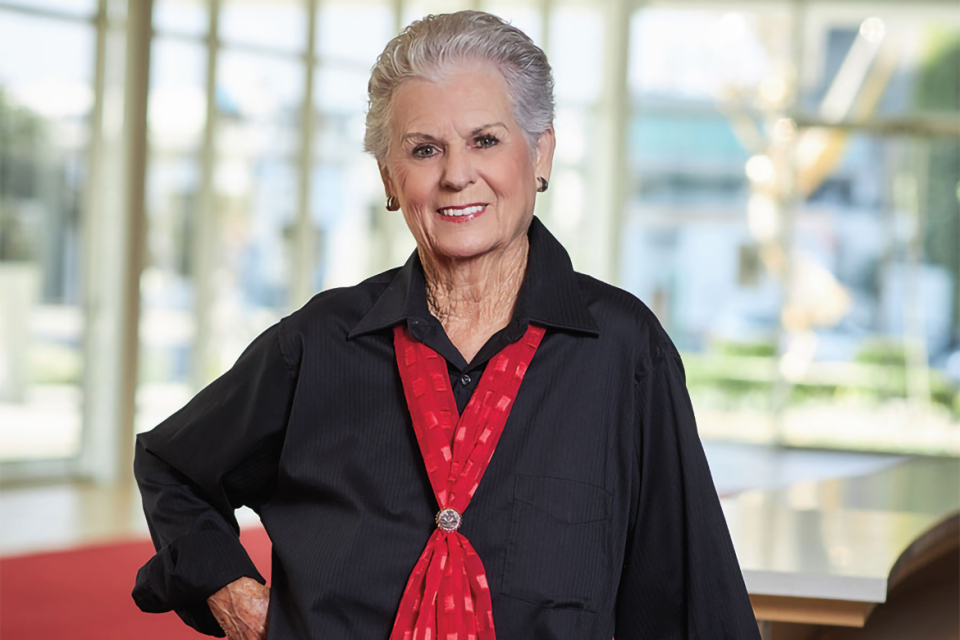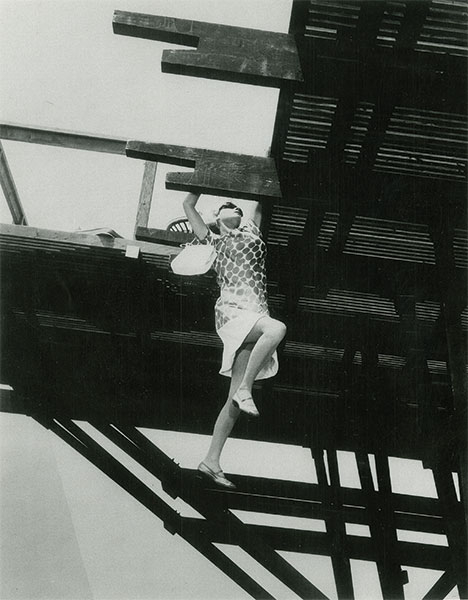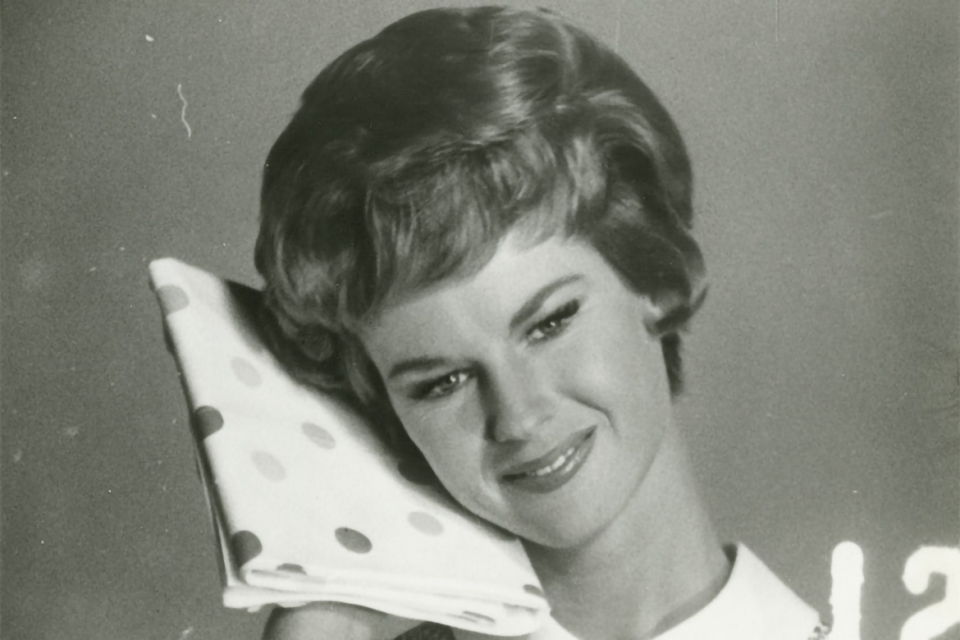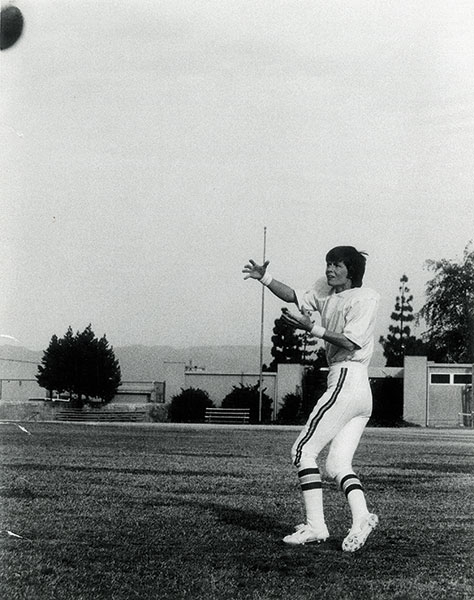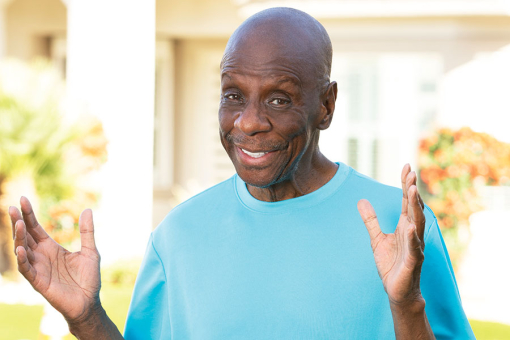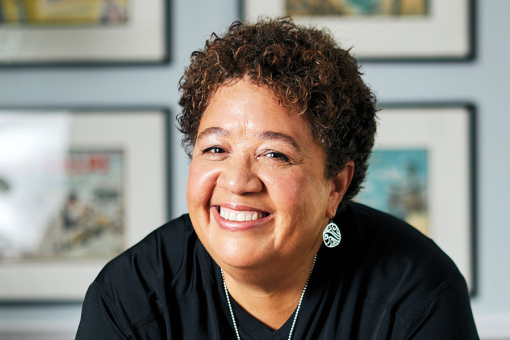When Julie Ann Johnson jumped over an ironing board in the early 1960s for a spray starch commercial — and jump-started her career as a stuntwoman — the industry was still decades away from significant safety guidelines and mandatory training.
With little more than an athletic background and a willingness to try her best, Johnson was soon working regularly in television and movies, taking falls on camera for the likes of Doris Day, Lynda Day George and Susan Saint James.
She drove speeding cars, jumped from heights and hung from hot-air balloons, all the while making the best of jobs that required high heels and tight clothing with no room for protective pads. But her upward climb ended in 1980, after she was badly injured on the set of Charlie's Angels.
Johnson says her phone stopped ringing after she spoke up about the mistakes that led to the accident. "I don't want any more stuntwomen to have to go through what we went through," she says. "When you're talented and you want to use your skills, you belong in this industry. There's not a stunt that a woman can't do if it's rigged right."
In 2013 she published a memoir, The Stuntwoman (cowritten with David L. Robb), in which she details her fight against sex discrimination in the industry and its destructive effects on her career.
In 2017 she met with SAG- AFTRA president Gabrielle Carteris to argue against the practice of stuntmen doubling as women and white stunt workers putting on dark makeup to double for minorities, issues she has been protesting for decades.
Born in Fullerton, California, Johnson was raised in an athletic family. Her grandfather, Samuel Earl Crawford, played for years for the Detroit Tigers and Cincinnati Reds, and was inducted into the baseball Hall of Fame in 1957.
Johnson was interviewed in February 2019 by Adrienne Faillace for The Interviews: An Oral History of Television, a program of the Television Academy Foundation. The following is an edited excerpt of their conversation and Johnson's answers. The entire interview can be seen at TelevisionAcademy.com/Interviews.
Q: Did you play a lot of sports, growing up?
A: I could play any sport. In my senior year of high school, I got an award for having the most credits in the Girls Athletic Association. I played after-school sports, whatever the season was.
Q: Were you a daredevil?
A: I wouldn't say a daredevil, but I was fearless. In my freshman year, basketball was one of my favorite sports. I was at my neighbor's house, practicing after school one night, and I threw a hook shot that hit the rim and bounced behind the backstop. I had to go up on the roof to get the ball.
So I hopped the fence, got on the roof and then I couldn't resist — once I got the ball, I dropped it over the basket, but the whole backstop gave way and I went down headfirst to the cement. I broke my fall with my hands, and I shattered both wrists. I was in two casts, with my arms bent, for over three months.
Q: How did you get into stuntwork?
A: Stunts found me — I didn't find stunts. I was working in retail and became an assistant manager at Bullock's [department store]. Then I became the switchboard operator at a commercial production company for $100 a week. I was there for two years and learned a lot about production. Sometimes clients would come in and say, "You'd be a great double for Doris Day."
I asked, "What's a double?"
I was told, "They're the ones that do the dangerous stuff so the actress doesn't get hurt."
A lightbulb went off. I wondered, how do you become a double? I found out that there was an answering service in town for stuntpeople called Teddy O'Toole's. Production companies would call Teddy's and say, "Send me four or five girls who are five-six and weigh 110 pounds." Then you'd get an audition to go meet the director on the set.
So I started at Teddy's, and I would perform whatever they wanted. I did a lot of learning on the job.
Q: Did you have to audition for Teddy's?
A: I pulled together a résumé, and I had on there that I was an athlete. Teddy explained the business to me. She said, "I'll send you on the jobs I think you're right for."
I got a commercial for Magic Sizing spray starch in which I jumped over an ironing board. They reversed the film, so it looked like I was jumping back and forth over the board. That was a good credit. I think I made $16,000 total for that commercial. I thought, "Wow!"
I had gotten off the switchboard and become the production assistant, then production coordinator at the production company, but I was being called away more and more to audition for stunts. Finally the company president came to me and said, "Julie...," and I said, "I know. I've got to pick one job or the other. I've got to pick stunts."
Q: Was any special training required to do stuntwork?
A: No. I took some judo and karate lessons. My stunts in the beginning were falls — pratfalls, stair falls — some running, some driving.
Q: How did you became Doris Day's stunt double?
A: I got an audition to double for Doris Day on the [1967] movie Caprice. I went out to 20th Century Fox and met the unit manager. There was another girl there, but she was a lot shorter. The unit manager looked at me and said, "You're perfect. You're going to go up to Mammoth Mountain and hang from a helicopter ladder for about 40 feet."
When I was on location in wardrobe, the unit manager brought Doris in to okay me. She said, "She's kind of skinny, isn't she?"
He said, "Don't worry about that. We're going to fill her out."
From then on, I doubled her. When she had her CBS show [The Doris Day Show, 1968–73], I did all of the titles for her in San Francisco — jumping on and off cable cars and running down the street, riding a bicycle. And any time she had a little fall or something like that to do, I would do it.
Q: When you're doubling someone, do you work with her to observe her movements?
A: You try to emulate her as much as possible — the way she moves, acts, everything. You become very observant.
Q: You also worked on the '60s spy series The Man from U.N.C.L.E. ...
A: I did Man from U.N.C.L.E. and The Girl from U.N.C.L.E. — once in a while I'd do a little nondescript [ND] role.
Q: What's that?
A: Nondescript work could be anything. There's just a piece of action that doesn't require a double and they need people. Like in a barroom fight, something like that.
Q: Was it common for stuntpeople to get those kinds of jobs?
A: Yes, but most of the nondescript jobs go to men.
Q: Why is that?
A: It's a buddy system. They often get hired by the coordinators, who are mostly men. We've been fighting that for a long time. If you've got six ND stuntpeople, why aren't three of them women? [Unit production manager] Abby Singer helped me get ND work. He was at Universal at the time. Universal was the first major studio that I worked for.
Q: Star Trek was another major series you worked on....
A: Yes, I did that with Paramount [in 1967]. I doubled Celeste Yarnall in a fight scene. Once they put me in costume and hair, we looked like twins.
Q: In those days, did your wardrobe include protective gear?
A: In the early days, they put you in tight clothes. There was no place to put a pad on the elbow or knees, or anywhere else, and that's when the injuries can come. You get hurt.
Q: Did you have to work in high heels?
A: Those were ankle busters, and always difficult — running in heels, especially. But I had worn heels when I was working for Bullock's, so I was used to them.
Q: As a stuntperson, who do you work most closely with on set?
A: Well, special effects is very vital to you. And of course, the stunt coordinator. But there weren't a lot of coordinators when I started out. It was just you and the director.
Q: When did that start to change?
A: In the 1970s. Kathleen Nolan, our first female president of the Screen Actors Guild — I can't say enough about her. She and Norma Connolly, who was head of the SAG women's committee in the '70s, they were known as the Dynamic Duo.
The greatest gift that Kathleen gave to stuntwomen was to say, "My door is always open to you. Always." No other president has said that. They started the first stuntwomen's subcommittee, and we would meet maybe once a month. It gave stuntwomen a chance to air their grievances.
Q: What were some of the grievances that you had in the '60s and '70s?
A: Men doubling for actresses. We could have done the jobs that they did. But I wasn't called for those jobs, and none of the other stuntwomen were called. Another problem was the "paint downs," where they'd put makeup on you to double for someone of a different race. Nobody stopped this from happening.
Also, at that time there weren't many women coordinators. Now there are a few. We would complain, but you couldn't complain too much, because the stuntmen's groups controlled hiring, and your phone's not going to ring if you're complaining.
Q: You worked on a 1972 TV movie, Women in Chains, in which Ida Lupino plays a parole officer who goes undercover to investigate prison brutality....
A: I coordinated a little fight for that show, a tussle.
Q: Was that your first time doing coordinator work?
A: Yes. I think the time I enjoyed coordinating most was on Pete 'n' Tillie at Universal, with Carol Burnett and Walter Matthau. I coordinated a fight for Geraldine Page and Carol Burnett. The director said he didn't want to see the typical fight in which women are pulling hair and wrestling around. So I designed a fight with props that played off their dialogue.
I was able to use my brains and design something where the actresses wouldn't get hurt and have some fun.
Q: And in 1975 you formed the Society of Professional Stuntwomen? Tell us about that organization.
A: We were openly fighting [critical] issues — men doubling women, paint downs — but so much of that fight came to a screeching halt after another stuntwoman and I were hurt on Charlie's Angels.
Q: Had you been injured on set before then?
A: Yes, though you often don't know you're injured until the next day, because your adrenaline's working and you don't think about it. You might hurt a little bit, but it's the next day or the third day that you realize something's not right.
Once, on an episode of Mannix, I rode tandem behind a guy on a motorcycle, and we were playing chicken with Mannix's car [along with a couple on a second motorcycle]. All of a sudden, the driver of the car started slowing down, and the girl on the back of the other motorcycle wound up kicking my front tire. I went up in the air and landed on the motorcycle on my ribcage. I went home and it was hard to breathe.
The next day I went to the doctor and he said, "Your floating rib's cracked. You tore cartilage. Another rib's got a hairline crack. Get the ice." I was black and blue, but those kinds of things happened.
Q: So let's talk about Charlie's Angels [the original ABC series, 1976–81]. You started doing stunts on the show in 1976?
A: Yes. A new coordinator came in, and he called me in to double for Kate Jackson. I doubled Farrah Fawcett a few times, and Jaclyn Smith once or twice, but mainly Kate. I was on it for four seasons.
Q: And you became a coordinator on the show?
A: I was coordinating some of the episodes. [Stunt coordinator] Ronnie Rondell would go do Hart to Hart or other shows, and I would be left to finish or take over an episode.
Q: How did you get injured?
A: I was doubling Farrah Fawcett and [stuntwoman] Jeannie Coulter was doubling Cheryl Ladd. We were out on an airstrip rehearsing a scene where we were going to jump out of an old Ford station wagon. We were in the backseat — Jeannie was on the right and I was on the left. We rehearsed it a couple of times to try to get the speed right.
They placed a couple flags on the runway, and we had to be out of the car by the time the car hit the flags.
After rehearsal, Jeannie's wig wasn't on tight enough, so she went to the dressing room to get it fixed. I stayed at the car. A guy walked by and said, "Bobby got the last of the coke this morning." I thought, 'Who's drinking Coca-Cola at eight-thirty in the morning?' Then Bobby came racing out, got in the driver's seat and Jeannie got in.
Prior to getting in, I said, "You're never going to see me — there's no camera on my side."
The assistant director said, "We've got a low camera and a high camera; we'll see you on the high camera." I said, "Not for what I'm doing on that side," and she said, "Yes, we will."
So I didn't mess with her. But sure enough, in the actual footage, you barely see my door open. But now we're in the car, speeding down the road, and Bobby wasn't slowing down. We saw the flags coming up and we knew we had to jump out. We felt the car slow down, so we opened our doors. We were in position to move out, and Bobby stepped on the throttle.
The doors came back at us and slapped us, practically back into the car. We couldn't get out correctly and Bobby kept going.
The doors kept swinging back and forth. Jeannie jumped out. It was supposed to be a tuck and roll, and I was trying to get in position to get out. But my foot slipped. I kicked off to get out and away from the car, and as I did, I landed on the back of my head and my neck and flipped over. I was in convulsions on the ground.
I saw light all around me. Jeannie had the same feeling. She got on her feet, but I was still in convulsions.
I was starting to come to and I said, "I think I broke my back. I can't move my legs." It turned out someone was lying on me to keep me still from the convulsions. They gave me a few more minutes, then stood me up; they brought over a couple of chairs for us to sit in. We sat there a minute, both of us dazed.
They took us to the hospital to get checked out. We had concussions and were told to have our doctors check on us the next day and make sure somebody woke us up every two hours during the night. The next day, I got my neck X-rayed and I had a hairline fracture.
Q: But you went back to set on the day that you got injured?
A: Yes. We had one more shot to do. So when we got back from the hospital, we got something to eat and went back out to the runway. We both had to do another running stunt. That's what we did: we finished the shot and then went home.
Q: Did you file paperwork about the injury?
A: The production said OSHA [the Occcupational Safety and Health Administration] was notified, but we never got a call from OSHA. Nobody talked to us. We started talking to other crewpeople because they asked what had happened.
I felt what happened was that our driver was under the influence. If that happens, your timing is not going to be correct. If we miss our mark, or overslide our mark, somebody's going to get hurt. Somebody's going to get killed.
Q: Did you voice your concerns about the driver?
A: Absolutely. I voiced it to my superior. I had also complained about our automobiles. Each Angel had her own car. In the four years we were driving them, nothing was done to keep them in shape. We're expected to do great stuff with these cars, but the shocks are bad, brakes go to the floor.... They just needed to be upgraded, and they weren't.
I wrote three letters to Aaron Spelling [the executive producer of Charlie's Angels, who died in 2006], asking to speak with him. I called three times. I was told, "Oh, he's in pilot season... He's too busy... He can't see you...." It behooves any producer to speak to a stuntperson. You owe it to them to listen to what they have to say.
Q: Did you stay with the show for the remainder of its run?
A: No. My phone barely rang again after I got injured. Because I said why I got hurt. That's what blows my mind, to this day. All of the footage that I'd given the industry over the years — I got hurt and said why I got hurt and now I never work again? Our phones had never stopped ringing for years, and then after this Jeannie and I were blacklisted.
I don't want any more stuntwomen to have to go through what we went through. When you're talented and you want to use your skills, you belong in this industry. Stuntwomen are still trying to be defined and I'm trying to elevate them to parity, to where we should be. There's not a stunt that a woman can't do if it's rigged right. There have to be changes.
Q: What did you do after your injury?
A: I fought for my career and sued Spelling-Goldberg Productions. I won the suit and the jury gave me a million-dollar verdict. But Spelling-Goldberg appealed, and the case took another four years. It ended in 1992, and I never saw a dime. I lost the appeal.
Q: What would you like to see happen in the stunt industry?
A: For years, stuntmen have held the power as coordinators and they control hiring.
Often when women are hired, it's because of connections, not because they're qualified. That doesn't serve our industry well. I want to see the best of the best working; I want to see diversity. So I propose a stuntwoman roster of qualified women.
To make the Olympics, you have to qualify. You have to qualify to get a driver's license. You should have to qualify in your area of expertise as a stuntwoman. If I were coordinating, I would want a roster so I can assure my producer and director that I have the best of the best doing a stunt.
This article originally appeared in emmy magazine, Issue No. 11, 2019

